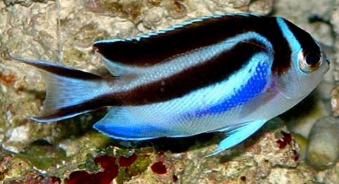Bellus Lyretail Angelfish
Category: Angelfish

Facts about Bellus Lyretail Angelfish, "Scientific name for Bellus Lyretail Angelfish is Genicanthus bellus", Bellus Lyretail Angelfish is one among the best supposed reef-protected angelfish that belongs to the Pomacanthidae family. The Bellus Lyretail Angelfish is a variety that belong to the Genicanthus type, and are native to Indonesia and they are ideal for the angelfish-prepared saltwater aquarium. They are also called as Ornate Angelfish and in Indonesia; they are called as the Boray-Boray. The Bellus Lyretail Angelfish variety is relatively small in size, strong and gorgeous. Unlike the majority of angelfish, they are inclined to leave invertebrates unaccompanied, making them one among the few angelfish suitable for a reef tank with a minimum capacity of 100 gallons (378 liters). The Bellus Lyretail Angelfish breed prefers a humid reef tank with an abundance of swimming space and caves for sheltering and hiding purposes.
Features
The Bellus Lyretail Angelfish is a non-violent angelfish, attaining a maximum body length of 7 inches (17.7 cm) when matured. The female Bellus Lyretail Angelfish breed appears considerably different from the males, with the male fish having fairly a bit of yellow on their body, whereas the female fish has none. This is a mid-water fish that looks closely at the minute mouth that contains many rows of short quill-like teeth tailored for feeding plankton from the water column. This dentition indicates that, unlike other fish varieties in its family recognized to choose at sessile invertebrates and corals, the Bellus Lyretail Angelfish breed can be maintained in a reef container with confidence. This fish is recognized to live in depths of 328 feet (100 meters) down the edges of external reefs in the wild.
Diet
The fact is that a Bellus Lyretail Angelfish are omnivorous, (definition-they eat both other animals and plants). Bellus Lyretail Angelfish breeds are omnivores, and in the aquarium, they are fed with a variety of foods, such as brine shrimp, Mysis shrimp, Spirulina algae, Angel Formula, broccoli, or foods rich in Zoecon.
Breeding
Bellus Lyretail Angelfish breeds are hermaphroditic and they have the capability to change gender from female to male, and male breeds can even turn back to female if no female fish are available in the aquarium. The Bellus Lyretail Angelfish varieties are complicated to breed, but several experienced expert aquarists have observed the Bellus Lyretail Angelfish, spawning successfully on a regular basis in extremely big home aquariums.
The average lifespan of the Bellus Lyretail Angelfish breed ranges from 10 years to 15 years. When first get your, Angelfish it may need to be given live foods such as freshly chopped seafoods or brine shrimp or to encourage them to eat.
In the wild Bellus Lyretail Angelfish like hiding in areas near caves where there is soft and stony corals. That's were the Angelfish feed on tunicates, sponges benthic algae and weeds.
Ideal aquarium water temperature for your fish is between 72 to 78º F (22 to 25.5º Cel) and pH from 8.1 to 8.4. The specific gravity at 1.020 to 1.025.
Bellus Lyretail Angelfish Aquarium care
Test the water when preparing your tank for your Bellus Lyretail Angelfish: You will need to purchase a liquid tester so that you can test for Nitrates and Ammonia. The strip-style test kits are unreliable and a waste of money. You should use a dechlorinating product to remove the harmful chlorine from the water. Test for nitrite, ammonia, and proper PH. The ammonia should always be 0, the nitrite should be 0, and the nitrate should preferably be below 20 ppm. If it's at or above 40 parts per million (ppm), you have too many fish or are not changing the water often enough. Cycling your tank is important, Follow the steps to cycle your tank. This establishes healthy bacterial and chemical levels.
When buying your Bellus Lyretail Angelfish see which one looks like the healthier fish in the tank. Be wary of tanks with dead fish in them, as this can be a sign of illness or improper care. Clamped fins are a sign of illness. In addition, healthy Bellus Lyretail Angelfish will have no white spots, make sure they swim with their fins held upright, and have a nice rich color or colors. Make sure they swim all over the tank and look healthy.
When adding the Bellus Lyretail Angelfish to the aquarium, it is important to introduce the Bellus Lyretail Angelfish to the tank environment slowly. As soon as you get home, float the entire, closed pet store bag (with the Bellus Lyretail Angelfish inside!) in the tank on top of the water for about a half hour. This will allow the water in the plastic bag and the Bellus Lyretail Angelfish to equalize out to the same temperature as in your tank, so your Bellus Lyretail Angelfish does not get shocked by the different temperature. Next, add a small amount of water from your tank to the bag, and wait about 15 minutes. Do this at least one more time. Us a net to catch your Bellus Lyretail Angelfish and then while the fish is in the net, dispose of all the water down a drain or outside. Then transfer the Bellus Lyretail Angelfish carefully into the your tank. This process not only reduces stress for you Bellus Lyretail Angelfish, it also prevents the dirty pet store water from contaminating your tank with disease.
Remove 30% of the water from you Bellus Lyretail Angelfish tank each month with new water, or a 15% water change every 2 weeks is ideal for keeping nitrates lower. With corals in the fish tank, then 20% water change every month, or 10% change every 2 weeks.

 Back To Category Angelfish
Back To Category Angelfish